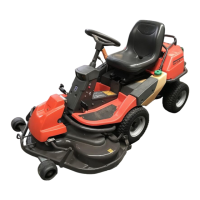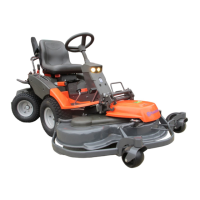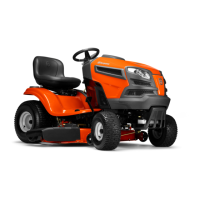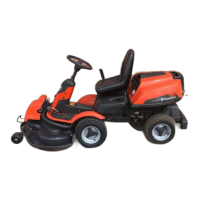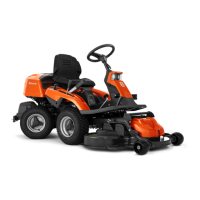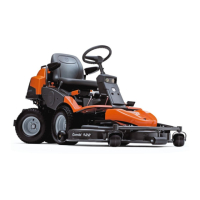
Do you have a question about the Husqvarna Rider Pro 18 AWD and is the answer not in the manual?
| Brand | Husqvarna |
|---|---|
| Model | Rider Pro 18 AWD |
| Category | Lawn Mower |
| Language | English |
General guidelines for safe operation and maintenance of the rider.
Specific warnings related to fuel, compressed air, and sharp components.
Precautions to avoid battery explosion, fire, or eye injuries from sparking.
Lists and illustrates specialized tools required for specific repair tasks.
Technical details on machine size, weight, and capacity with attachments.
Information on tyre specifications and air pressure requirements.
Details about the engine manufacturer, model, power, and fuel requirements.
Specifications for front and rear drive axle types and oil.
Electrical system components, battery type, fuses, and bulb specifications.
Details on hydraulic pump type and working pressures.
Specified torque values for various machine components.
Specifications for different cutting unit models, including width and noise.
Tolerances and measurements for checking cutting unit alignment and function.
Specified acceptable play for control cables and levers.
Step-by-step procedure for preparing the rider for customer delivery.
Maintenance tasks required after 8, 50, 25, 50, 100/200 hours of operation.
Major service requirements for the 300-hour interval.
Seasonal maintenance tasks to ensure optimal performance.
A comprehensive table outlining maintenance tasks by interval.
Guidelines for dealers on customer delivery and information provision.
Instructions for safely unpacking the machine from its shipping packaging.
Procedures for filling, charging, and fitting the battery correctly.
Dealer responsibility for fitting arm supports if supplied.
Instructions for fitting the steering wheel to the steering column.
Guidance on fitting the tow hook and counterweight.
Steps to check the engine oil level using the dipstick.
Procedure for checking the hydraulic oil level via the sight glass.
Instructions for fitting wheels and setting tyre pressure.
Dealer responsibility for fitting skid guards if provided with the machine.
Steps for checking and adjusting the cutting unit's alignment.
Procedures for safely testing the machine after initial setup.
Safety checks and steps for starting the engine correctly.
Checking and verifying the engine's maximum speed settings.
Procedure for checking muffler security and tightening torque.
Final checks and procedures after test running and before handover.
Documentation tasks including filling sales papers and service journals.
Overview of the Husqvarna Rider series and its features.
Description of the different cutting unit types available for the riders.
Location and identification of machine, engine, and transmission serial numbers.
Information about the Kawasaki twin-cylinder engines used in the riders.
Explanation of the articulated and hydraulic servo steering system.
Details on the hydrostatic transmission and AWD drive system.
Detailed breakdown of cutting unit components and their functions.
Step-by-step guide for safely removing and installing the engine.
Procedures for removing and fitting the fuel tank.
Steps for cleaning the pulse air valve intake filter.
Guide for draining old oil, replacing the filter, and refilling with new oil.
Process for checking and adjusting steering cable tension for proper steering.
Detailed steps for removing and fitting new steering cables.
Procedure for removing and installing the power steering unit.
Steps for disassembling and reassembling the cable pulley.
How to adjust the parking brake for correct operation.
Procedure to adjust the hydrostatic transmission cable for proper function.
Steps to check and adjust the throttle cable for correct engine speed.
How to adjust the choke cable for optimal starting and running.
Detailed process for replacing bearings in the articulated steering system.
Steps for safely removing the pendulum shaft.
Instructions for replacing bushings in the rear frame.
Guide for installing the pendulum shaft and related components.
Procedures for removing and fitting the hydraulic pump unit.
General notes on drive axle maintenance and specific instructions for front/rear axles.
Steps for removing and dismantling the front axle.
Instructions for removing and dismantling the rear axle.
Procedure for synchronizing wheel drives for correct cornering speed.
Detailed steps for replacing seals on outgoing shafts.
Instructions for removing and fitting the hydrostatic transmission cable.
General information and schedule for transmission oil changes.
Procedure for changing oil in the front and rear hydrostatic transmissions.
Steps for replacing the hydraulic tank's suction filter.
How to adjust the lever housing for proper cutting unit control.
Detailed procedure for replacing the hydraulic pump drive belt.
Instructions for replacing the centre belt on the cutting unit.
Steps for removing and fitting the front belt for the Pro 18 AWD.
Instructions for replacing the front belt on the ProFlex 21 AWD.
Procedures for removing and fitting the equipment frame.
Identification and description of ProFlex cutting unit components.
Step-by-step guide for attaching the cutting unit to the Pro 18.
How to place the Pro 18 cutting unit into its service position.
Detailed steps for putting the Pro 18 cutting unit into service position.
Instructions for attaching the cutting unit to the ProFlex model.
Procedures for safely releasing the Pro 18 cutting unit from service position.
Guide to adjusting the cutting unit's parallelism and cutting height.
Specific steps for setting the cutting height for different combi units.
How to adjust the overall range of cutting height settings.
Procedure for checking and adjusting the cutting unit's ground pressure.
How to position the ProFlex cutting unit for service and maintenance.
Detailed steps for placing the ProFlex cutting unit into service position.
Procedures for safely releasing the ProFlex cutting unit from service position.
Instructions for removing the cutting unit from the ProFlex rider.
Steps for dismantling the equipment frame on ProFlex models.
Guide for replacing the V-belt on Combi cutting units.
Detailed process for removing blades and their associated bearings.
Instructions for sharpening and balancing cutting blades.
How to remove the BioClip plug for rear ejection conversion.
Overview of the electrical system, wiring diagram, and component identification.
Procedure for removing and fitting the ignition and starter lock assembly.
Instructions for removing and installing the hour meter.
Information on fuse types, locations, and replacement.
Steps for replacing the headlamp and other light bulbs.
Explanation of the rider's safety interlock systems.
Information on the mowing deck microswitch and its adjustment.
Details on the seat microswitch and its replacement.
Adjustment procedure for the microswitch related to pedal operation.
Essential practices for maintaining the cleanliness of the hydraulic system.
Visual guide to identifying key hydraulic system components on the rider.
Procedures for removing air from the hydraulic system.
Reference to power steering removal/fitting instructions.
Step-by-step guide for replacing the lift cylinder on ProFlex models.
Instructions for removing and refitting the hydraulic valve assembly.
Procedures for changing the hydraulic oil filter and oil.
Steps for replacing the control valve on ProFlex models.
Detailed procedures for dismantling and assembling the control valve.
Information on troubleshooting low hydraulic pressure related to the valve.
Identification and routing of hydraulic hose bundles.
Troubleshooting steps for when the starter motor fails to engage.
Diagnosing issues related to fuel delivery to the engine.
Steps to identify and resolve problems with the fuel supply system.
Troubleshooting steps for ignition system failures affecting the spark plug.
Issues related to spark plug condition and thermal value.
Problems arising from incorrect ignition timing or settings.
Diagnosing failures in the ignition module or related sensors.
Troubleshooting low fuel levels or delivery issues.
Issues caused by a dirty or clogged fuel filter.
Problems related to fuel lines being obstructed or kinked.
Issues arising from improper carburettor settings or faults.
Troubleshooting a blocked tank vent affecting fuel flow.
Problems caused by a dirty or blocked air filter restricting airflow.
Correct spark plug selection based on thermal rating.
Issues related to incorrect pre-ignition timing.
General incorrect settings affecting engine performance.
Carburetor jet blockages causing poor running.
Engine damage or poor performance due to low oil levels.
Overheating issues caused by obstructed engine cooling.
Problems arising from a faulty or damaged cooling fan.
Issues related to the choke system's operation.
Procedure for checking and adjusting the choke cable and valve.
Engine performance issues due to overloading the machine.
Adjusting operator technique to avoid overloading.
General ignition system faults affecting engine performance.
General troubleshooting for carburetor related issues.
Diagnosing and fixing engine overheating problems.
Interpreting exhaust smoke color as an indicator of engine issues.
Identifying signs of severe engine damage.
Method for testing engine compression to diagnose internal issues.
Causes and solutions for engine overheating.
Using the correct fuel type for optimal engine performance.
Issues arising from using stale or degraded fuel.
Problems related to fuel octane degradation over time.
Recommendation to replace old or degraded fuel.
Troubleshooting uneven engine operation or loss of power.
Issues related to the engine's exhaust system.
Diagnosing and fixing abnormal exhaust noises.
Issues with the drive belt's condition affecting power transmission.
Troubleshooting a malfunctioning drive belt idler.
Problems with the engine shaft pulley securing to the axle.
Issues with the wheel hub or axle slipping.
Drive belt slippage on the hydraulic pump's input shaft pulley.
Diagnosing internal leaks within the hydraulic pump.
Faults in the hydraulic motor or differential components.
Problems caused by a blocked suction filter in the hydraulic tank.
Insufficient hydraulic oil level affecting system operation.
Issues caused by air entering the hydraulic system.
Problems related to the bypass valve lever position.
Faults in the accelerator control mechanism.
Diagnosing internal damage to the transverse axle.
Issues with the brake system being improperly adjusted or stuck.
Maintenance for brake linkage and cables.
Problems with the rear drive belt condition or slippage.
Issues arising from damaged or missing keys in drive components.
Symptoms of the parking brake not fully releasing.
Safety requirement regarding the parking brake for certain operations.
Procedure for checking the proper functioning of the lock mechanism.
General issues related to the hydraulic transmission system.
Indication that the parking brake is engaged.
Symptoms of reduced machine speed or complete loss of drive.
Complete failure of the machine to move forwards or backwards.
Engine RPM dropping under load or operation.
Issues related to the drive belt for the hydraulic pump.
Problems with the transmission overheating.
Insufficient oil levels in the transmission or hydraulic system.
Inspecting and adjusting the belt tensioning system.
Problems caused by a worn or damaged drive belt.
Faults with the cooling fan impeller causing noise or damage.
Issues with loose or damaged pulleys affecting belt drive.
A blocked suction filter causing flow restrictions.
Problems identified within the front or rear axle assemblies.
General engine faults leading to low power or noise.
General faults within the transmission system.
Issues specifically related to the main drive belt.
Problems with the cooling fan associated with the hydraulic pump.
Issues with the belt pulley on the pump's input shaft.
General problems related to the hydraulic pump unit.
Diagnosing and fixing air ingress into the hydraulic system.
Problems when the front and rear axles are not properly synchronized.
Symptoms of reduced performance when operating under heavy load.
Identifying and resolving unusual noises originating from the transmission.
Issues caused by operating the machine beyond its intended capacity.
Adjusting operator technique to avoid overloading.
Diagnosing and fixing unusual noises from the cutting unit.
Issues caused by foreign objects interfering with moving parts.
Symptoms indicating the brake is not fully releasing.
Procedure to check and adjust the parking brake.
When to replace the entire transmission or internal components.
Incorrect connection of the throttling mechanism.
Correct positioning of the throttling control.
Diagnosing internal damage to the pump or drive shaft.
Recommendation to replace damaged units.
Diagnosing unusual noises during machine operation.
Suspected drive shaft issues causing noise.
Unusual noises occurring when the machine is stationary.
Suspected faults within the hydraulic pump causing noise.
Symptoms and causes of transmission overheating.
Issues related to inadequate airflow around the transmission.
Faults with the cooling fan affecting transmission temperature.
Action to take if the cooling fan is damaged or loose.
Ensuring correct engine oil level for transmission cooling.
Consequences of low oil levels in the transmission system.
Removing dirt and debris from cooling surfaces.
Specific cause of poor air circulation affecting cooling.
Symptoms of the brake system not fully releasing.
Procedure to check and adjust the parking brake.
When to replace the entire transmission or internal components.
Incorrect connection of the throttling mechanism.
Correct positioning of the throttling control.
Diagnosing internal damage to the pump or drive shaft.
Recommendation to replace damaged units.
Problems with the engine starting smoothly.
Faults in the accelerator control mechanism.
Issues related to jamming, damage, or spring failure in controls.
Ensuring correct engine oil level for transmission cooling.
Consequences of low oil levels in the transmission system.
Problems with the rear drive belt condition or slippage.
Inspecting and adjusting the belt tensioning system.
Problems caused by a worn or damaged drive belt.
Maintenance for belt adjuster bearings.
Recommendation to replace worn drive belts.
Issues related to the return spring and cams on the hydraulic pump.
Common mowing problems attributed to operator actions.
Mowing issues caused by mechanical faults in the machine.
Problems related to the cutting unit's condition or adjustment.
Engine-related issues causing uneven mowing or vibrations.
Causes and troubleshooting for excessive machine vibrations.

